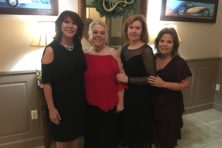CURIOSITIES: What’s the Story with that Roof at Door County Medical Center?
- Share
- Tweet
- Pin
- Share

As the Door County Medical Center’s new Sister Bay clinic took shape last year, the most common question asked wasn’t what services or doctors would be inside the new clinic once it opened in the spring. Instead, people asked what the story is behind that strange, folded-plate roof – and how it would handle the snow of a Wisconsin winter.
The project’s lead architect, Michael Crawford of Caldwell Associates in Pensacola, Florida, said the roof not only creates a dramatic profile, it also includes several elements to hold up to heavy snow.
The valleys are reinforced structurally to support the inevitable snow loads they will encounter, but the roof is also a “cool roof,” in that the temperature stays consistent to melt snow slowly and evenly.
Though from ground level it looks as though the roof has four large valleys, there is actually a subtle center ridgeline that runs perpendicular to the folded plates and helps to move snow and water to the outside of the roof. In each valley, there is a heat-tray system to help facilitate snow melt.
Crawford originally sketched a concept with heavy timber, but said that proved too costly to build and maintain. That wood idea was retained, however, underneath the roof over the south-facing patio to create an attention-grabbing profile from the street.
The peninsula’s distinctive architecture, which Crawford discovered during his initial site visits, inspired the project design.
“Norwegian and Northern European architectural forms have a dramatic roofline,” he said. “You see it in chalets, churches. Even a barn in an open field has a strong presence. That creates the profile or shape of the building as you come up on it. So we thought we’d come up with a design that had a striking form. There are a lot of buildings that look like condos, but that’s not what the spirit of the place really is. The barns, silos, churches, lighthouses – those create the culture of the place.”
Crawford – and the hospital – did not want to erect something that looked like a typical, boxy medical building.
The final form certainly doesn’t.




